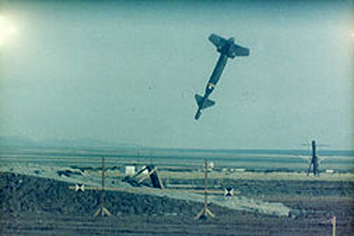What use will U.S. officials find for America’s new “bunker busters”?
In July 2012, the United States’ Air Force Secretary Michael Donley announced that the Air Force’s 30,000-pound ‘bunker buster’ was ready to be used “if needed.” However, then-Defense Secretary Leon Panetta emphasized that the bomb, a Massive Ordnance Penetrator (MOP) designed to destroy deeply buried bunkers that protect weapons of mass destruction, was still unable to devastate Iran’s suspected underground nuclear complexes.
Nevertheless, since last summer, improvements made on the bunker busters are such that the MOPs are now capable of destroying the Fordo nuclear enrichment complex, Iran’s most heavily fortified and defended nuclear site buried under a mountain near the Iranian city of Qom. The newest version of the Pentagon’s largest conventional bomb has “adjusted fuses to maximize its burrowing power, upgraded guidance systems to improve its precision, and high-tech equipment intended to allow it to evade Iranian air defenses” in order to reach and destroy the nuclear complex. A field test on June 14, 2013 reportedly destroyed a replica of the Fordo nuclear facility.
[captionpix align=”left” theme=”elegant” width=”300″ imgsrc=”http://www.martinfrost.ws/htmlfiles/jan2012/qom-nuke-site.jpg” captiontext= “The suspected nuclear enrichment facility near Qom.”]
What is paradoxical about the bomb is that while it is now thought to be capable of eliminating the nuclear site with a first strike, its benefits are in fact defensive rather than offensive in nature.
Over the past decade, suspected Iranian nuclear proliferation has fueled tensions between Israel and Iran, contributing to each nation’s view of the other as its direct regional rival. The growing threat of a nuclear Iran has come to represent an existential threat to Israel, citing Iranian calls for Israel’s destruction, and its support for militant anti-Israel groups. This has led some to speculate that Israel might launch a preemptive strike against its rival. U.S. Defense Secretary Chuck Hagel recently stated, “Iran presents a threat in its nuclear program and Israel will make the decisions that Israel must make to protect itself and defend itself.” Hagel’s comments follow charges by Israel’s president Benjamin Netanyahu that without a credible threat of military action, Iran has little incentive to cut a deal on its nuclear program in negotiations.
However, former U.S. Ambassador Ryan Crocker warns that plans to preemptively attack Iran are fraught with complications and in the end are counter-productive. The worst case scenario, Crocker warned, would be an unsuccessful preventative attack upon Iran which would only fuel Iranian belligerence.
In light of such fears, preemptive attacks are a policy that the U.S. would rather not see Israel use unilaterally. U.S. officials believe that the enhanced bunker-busting capability could have the positive effect of discouraging Israel’s hawkish stance toward the Iranian program, reassuring them that, if need be, the U.S. can destroy the facility. Israel’s military cannot deliver what a U.S. official called “a knockout blow,” against Iran’s nuclear facilities, and the United States has not offered such capabilities to its ally. As such, it appears unlikely that Israel alone would be capable of derailing Iran’s nuclear ambitions. Thus, U.S. officials say they believe that the enhanced U.S. bunker-busting capability can persuade Israel away from launching a unilateral bombing campaign against Iran.
It is likely that by restraining Israel, the U.S. hopes to gain more time to pursue diplomatic means with Iran. American officials are optimistic that the ability to destroy the Iranian nuclear facility by air will give the U.S. considerable diplomatic leverage in its upcoming nuclear talks with the new Iranian president, Hassan Rowhani.
The U.S.’s new bunker-busting abilities give the country two distinct benefits: it buys more time with an impatient Israel, and it gives the U.S. strong diplomatic leverage at the negotiating table.
However, what the bombs themselves do not provide the U.S. with is any sort of strategic advantage. The potential use of the bombs to destroy Iranian facilities would likely incentivize and accelerate Iranian proliferation. As RAND’s National Defense Research Institute notes, opinion within Iran is divided with regard to the bomb: while many favour the development of nuclear weapons (notably those in the lowest classes and with the lowest education), there are also many opposed to nuclear weapons (notably those with the highest levels of education). In 2005, the supreme leader, Ayatollah Ali Khamenei gave an edict banning nuclear weapons in the country, an important stance in light of the Ayatollah’s considerable influence among both government officials and the domestic audience. However, should the U.S. decide to use its bunker-busting capabilities to eliminate Iran’s nuclear sites, it could compel a rethinking and perhaps repealing of the edict, and could create a resolve within Iran to proliferate for reasons of self defense and preservation of sovereignty. In other words, the use of the bunker busters has the potential to create very compelling reasons for Iran to seek a more effective nuclear capability, and would increase domestic resolve for obtaining atomic capabilities.
The U.S. should be careful with how it uses its new weapons. It seems that the bunker busters have considerable import as a restraint upon the U.S.’s belligerent Israeli ally and as potential diplomatic leverage in negotiations with Iran in the coming weeks. However, even if this round of negotiations does not prove successful, the U.S. should bear in mind the high potential costs of putting these 30,000 pound bombs to use. Increasing Iranian belligerence can only limit opportunities for cooperation long term. The paradox of these weapons is that their strategic value is of a diplomatic rather than a military nature.




